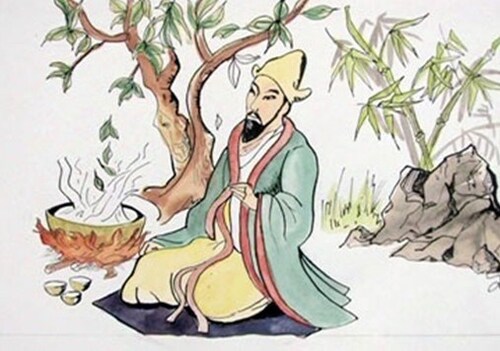-
One of the most popular heritage of China is tea culture. It is the national drink and that is not a legend. People are accustomed to drinking tea and it's usual serving tea to your guest and people you like.
Most of the time in the most traditional restaurants, the waitress served hot water flavored while we are waiting for the dishes to arrive.
Here a bit of history why is tea so appreciate in this country…
“The origin of Chinese tea can be tracked back to the ancient times, 5000 years ago. There are many legends which refers to its origin but one of the most popular is when Emperor Shen Nung discovered it: leaves from a wild tree blew into his pot of boiling water. He was immediately pleased by the resulting brew. By this time, the popularity of tea in China grew rapidly.
Emperor Shen Nung discovering tea flavor
It is used for its medicinal properties, for everyday pleasure and refreshment. It has won the statue of national beverage and the fashion of drinking tea had extended all over the country. Tea rooms and houses were built in order to enjoy tea at a social and spiritual level. Tea houses sprung up in the towns and cities. Men would gather there to gossip, and to take part in tea contests, where they would engage in "blind taste tests" of different kinds and qualities of leaves and water.
The art of making ceramic tea equipment was developed a great deal during this period.”
Tea House still part of daily life for the Chinese people nowadays. It is a place where they can listen to music, relaxed and admire works of tea art.
I couldn’t leave the country without having taken part to a tea ceremony. So I went to The Mid-lake Pavilion Tea House (湖心亭 hú xīn tíng), one of the most popular and oldest tea house in Shanghai. It was built in 1784 during the Qing Dynasty. It is situated right in the middle of the Lotus Pond at the Yuyuan Garden. You have to be careful choosing your tea house, because some of them are tourist trap. Tea ceremony scam in Shanghai are very usual. They make you paid overprice while the tea demonstration is over. The average cost per person is 100¥.
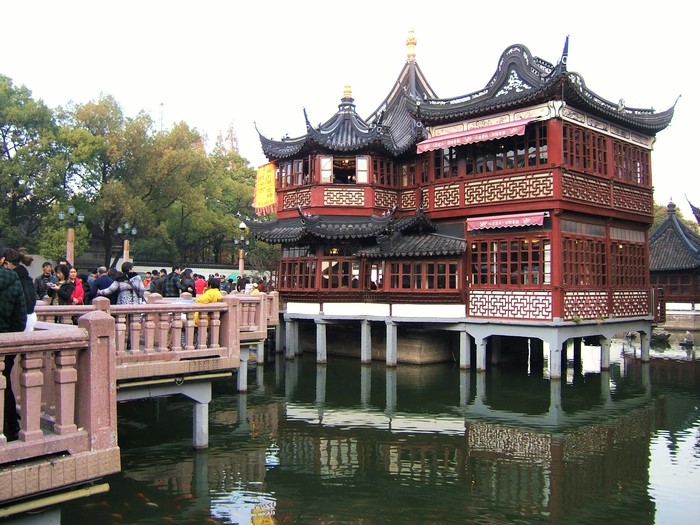
I learned how to brew a perfcet pot of Chinese Tea
• Step 1 Gather all the tools necessary to brew Chinese tea
Tea pitcher (1), tea pot (2), bowl (3), tea leaf holder (4), tea towel (5), tea pick (6), tongs (7), brewing tray (8), snifter cups (9), teacups (10), water and tea leaves.
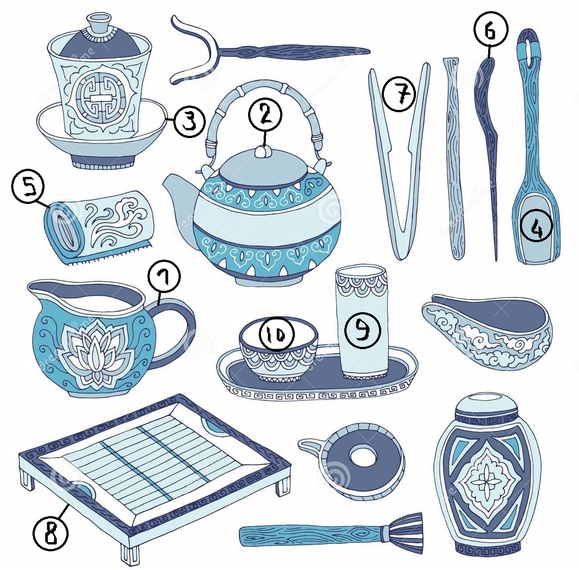
• Step 2 Prepare the Chinese tea set
Before brewing tea, teapot, cups and teacups must be heated and rinsed in a bowl.
• Step 3 Choose your tea
The traditional tea for tea ceremony is Oolong tea. So I choose a fruity oolong tea. To make Chinese tea, you use the tea leaf holder to scoop the loose tea leaves.
• Step 4 Tea brewing
Then add the right amount of tea into the teapot. This step is called 'The black dragon enter the palace'.
• Step 5 Heat the water to the right temperature (it depends of your tea). For the Oolong tea it has to be 35°C to 100°C heat. Place the teapot into the bowl and raise your shoulder while puting the heated water into the teapot until overflows.
• Step 6 Fill the tea snifers with tea by using the tea pitcher.
• Step 7 Don't drink it yet !
During a Chinese tea ceremony, you first poured tea into a small cup before being transfered to a round tea cup.
• Step 8 Time to pour the water
Just above the teapot so it keeps all the falvor of tea leaves.
• Step 9 Brewing time
Wait approximatly 10min for oolong tea to brew.
• Step 10 3 steps pouring !
Pour the tea into the tea pitcher first, then into the tea snifters, finally transfer the tea snifters to the tea cups.
Time to drink tea !
Good etiquette said that tea drinkers hold the tea cup with both hands to enjoy the tea's aroma before drinking. Take a first small sip, a second larger, the tird one is to enjoy the aftertaste.
To complete tea ceremony, pull the used tea leaves into the bowl. It is supposed to show to guests the tea quality.
It was a good experience, the chinese waitress was very kind even if she only talked chinese. The place is pleasant and relaxing, I recommande it !
 votre commentaire
votre commentaire
-
On this Thursday 9th and Friday 10th of June 2016, people in China were in working break. They were celebrated Duanwujie, the traditional holiday of the Dragon Boat Festival.
Backgrounds
It commemorates the life and death of the famous Chinese scholar Qu Yuan. He was a loyal minister of the King of Chu. He drawned himself into the Miluo River. People searched desperately for him in their boats but were unable to save him. Every year a festival is celebrated to commemorate this attempt at rescuing Qu Yuan.
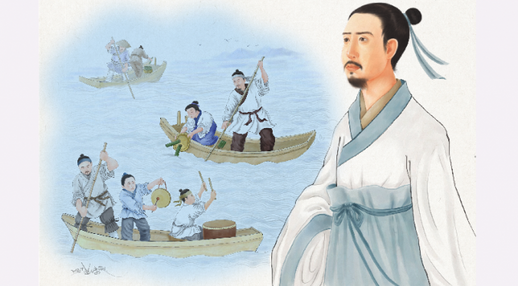
Chu inhabitants lookging for Qu Yuan
What people do ?
Boat races are held throughout China and Hong Kong. On Friday, we went to the Wusong River to see the arrival of the boats. The riverside was crowded. A dozen boats were racing.
People traditionally eat rice dumplings (zongzi), drink xionghuangjiu wine. Chinese citizens throw bamboo leaves filled with cooked rice into the water for Qu Yuan.
Zongzi
One of the traditional game is to make an egg stand at noon were regarded by the ancients as an effective way of preventing disease, evil, while promoting good health and well-being.
Picture of the Dragon Boat Festival
 votre commentaire
votre commentaire
-
- Regional geopolitical political context
China’s districts (sheng), are the highest administrative division in People's Republic of China. There are 34 divisions of this kind, divided into 23 provinces, 4 municipalities (including Shanghai), 5 autonomous regions and 2 special administrative regions. Each districts has a provincial committee of the Chinese Communist Party, headed by a secretary. The Committee Secretary is responsible for the province instead of the governor of the provincial government.
Shanghai is the largest city of People's Republic of China in front of Beijing with 23,019,148 inhabitants, and 6 340.5 km2 area. It is administrated as a municipality directly under the control of the Chinese government, with provincial-level government status.
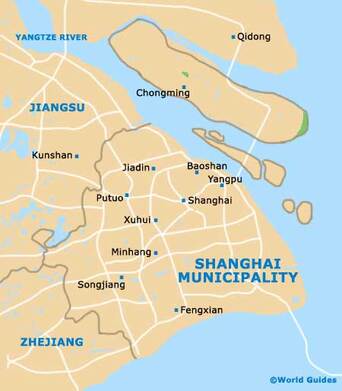
The Shanghai’s heads are
Mr. Yang Xiong, the Mayor

Mr. HAN Zheng, Communist Party Secretary
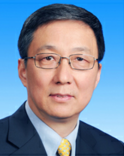
Shanghai is one of the most important economic and financial information centers of China. Its development is mostly because of its unique position at the mouth of the Yangtze (Blue River), which allowed the city to build into a major platform of international trade. Shanghai also takes advantage of the dynamism of its hinterland, which focuses almost ¼ of Chinese GDP. The city anticipate the pillars of the urban China of tomorrow.
- External regional conflicts or tensions
Regarding external conflicts, China is the enemy of many countries because of its regime.
- On of its major conflict is for the control of the South China Sea since 1970, especially for the Spratly Islands, due to the amount of resources it contains.
- Oppositions occur between Taiwan, China, Vietnam, Malaysia and the Philippines.
- There are tensions between China and India since the war of 1962, and for several reasons, such as maritime control or the Tibetan problem.
- As everybody knows, territorial dispute haven’t last yet with Japan, still linked with the maritime territory and the Senkaku and Diaoyu islands.
- The US has threatened to intervene in all these maritime disputes against China.
Many countries are therefore more or less in conflict with China, and particularly because of the maritime territory.
However, the country is founding many ways to avoid these conflicts, such as the creation of the Shanghai Cooperation Organization established in 2001, an intergovernmental organization which gathered Russia, China, Kazakhstan, Kyrgyzstan, Tajikistan and Uzbekistan.
It aims at improving relations between members, facilitating cooperation in major areas (political, economic, commercial, cultural, etc.) and especially preserve peace, security and regional stability.
- Internal conflicts or tensions in China
They are mostly characterized by :
- Rebellions and daily riots of the inhabitants who are opposed to the practices of the Party. The protests against the authoritarian regime are heard regularly. In the country, corruption is very strong, senior officials of the country are generally connected (often named) by members of the Chinese Communist Party. There is a ministry of propaganda which applies censorship on the means of expression such as the Internet, cinema or television. Censorship is routine in China, it is integrated into the country of the system. The facts of criminality and terrorism rather important in the territory are not highlighted. The Chinese Communist Party responds quickly to any threat to the regime. Nevertheless, this censorship admits limits, and in particular with the media that reveal truths that the Chinese government would rather keep quiet. The other parties that the official party have almost no existence.
The people seem to share in the country. While some appreciate the system by highlighting its role in the economic recovery, others criticize the increase in disparities and corruption present in everyday life.
- Conflicts with some regions who want their independence, such as Tibet, or with other regions in conflict with the central government such as Inner Mongolia and Xinjiang.
- Because many ethnic pressures (56 different ethnic groups in China), and the insistence of personal power. for example there is a suppression of other ethnic groups from those of the Han large majority in the territory. Xinjiang in particular, a major ethnic conflict is present with Uighurs.
- Inequalities and disqualifications due to migration. Shanghai heavily involved in a context of economic globalization and the migratory movement is increasingly high, which updates the phenomenon of growing inequality in China. Chinese provincial are immediately confronted with their arrival in town to situations of economic and social disqualification.
 votre commentaire
votre commentaire
-
China is a one-party state whose founding and ruling political party is the Communist Party of China (CPC). It is the second largest political party and it has ruled the country since 1949. Any opposition are tolerating and they often dealing with dissent. The Chinese government is known as the People’s Republic of China. The government’s power is divided among several bodies which are the legislative, executive, judicial and military branches, under the Politburo's directives.
 Elects/Approves
Elects/ApprovesThe National Emblem of the People's Republic of China
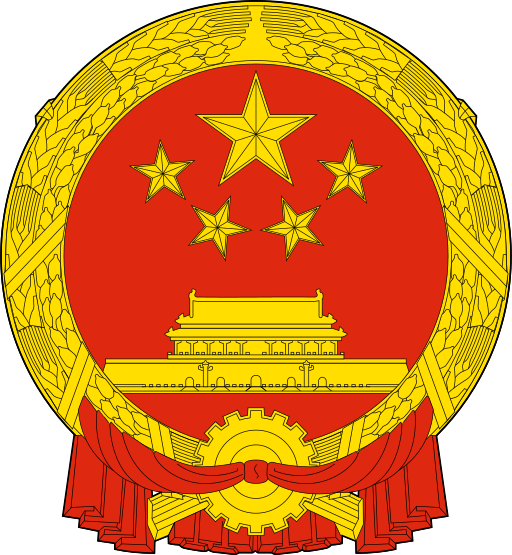
In the red circle, there is a representation of Tianamen Gate, the entrance gate to the Forbbiden City, where Mao declared the foundation of the People's Republic of China in 1949.
Upon it are represented the fifth national flag stars. The largest star represents the Communist Party of China, while the four smaller stars represent the four social classes as defined in Maoism. The design of four smaller stars surrounding a bigger one signifies the unity of the Chinese people under the leadership of the Communist Party of China.
The red color of the flag symbolizes revolution.
The outer border of the red circle shows sheaves of wheat and the sheaves of rice: they represent agricultural workers.
At the center of the bottom portion of the border is a cog-wheel that represents industrial workers.
 votre commentaire
votre commentaire
-
When we were in Hangzhou, we could see many posters and banners related to the G20. Indeed, China will host the eleventh G-20 summit this year. This is the first ever G-20 summit to be hosted in China and it will be held on September 4th and 5th 2016 in Hangzhou.
________
Reminder
The following list of G-20 summits summarizes all Group of 20 conferences held at various different levels: heads of government, finance minister and central bank governors, employment and labour ministers of the G-20 major economies, and others.
________
Xi Jinping, the Chinese President, recall G20’s members they should explore new ways to drive development and structural reform to put back the global economy on its feet, for a global recovery and growth.
This year, China has proposed four key priorities under the theme of the summit. It is towards forging a new path for growth, "more effective and efficient global economic and financial governance", "robust international trade and investment", and "inclusive and interconnected development." It also call for innovation in science and technology, in development concepts, institutions and mechanisms, and business models.
These previous days, thousands of volunteers were recruited in Hangzhou to support meetings. They signed up to help with the high-level international forum for government and central banks governors. There will be a strict selection for them (a short list of 3,000 people) to be “on-site volunteers”, who would work at the summit itself, and “city volunteers” who will help out with public security patrols, environment management and culture publicity in Hangzhou.
________
About the logo

The Logo for the 2016 G20 Summit incorporates a stylized bridge with 20 layered lines, symbolizing the 20 members of the Group. The characters “中国” (“China”) appears. The bridge signifies that the G20 is a bridge for global economic growth, international cooperation and a win-win future. The layered lines are fiber-optic cables, representing an inter-connected world in the information age. The letter “O” highlighted in the image of “G20” embodies unity and coordination among G20 members.
________
 votre commentaire
votre commentaire Suivre le flux RSS des articles
Suivre le flux RSS des articles Suivre le flux RSS des commentaires
Suivre le flux RSS des commentaires
